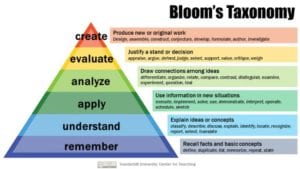“Mommy, Daddy, listen to me read this book!” These are magical words to hear from our children. Kindergarten and first grade teachers are thrilled when students read their first book independently. While this is very exciting news and big cause to celebrate, remember that being able to “decode” the words is only one part of the reading experience
Ultimately the goal of reading, regardless of age, is to understand and enjoy the message of the printed word and apply that understanding to novel experiences. Without understanding we describe readers as “word calling”’; that is, naming words without gleaning any meaning from them.
There are many levels of comprehension. According to Bloom’s Taxonomy, the most commonly referred to study of how people understand and what they do with that understanding, there are many levels of comprehension. While some of the higher order thinking skills may seem quite sophisticated for a 5 or 6 year old, adults can pepper conversations with questions that will help shape a child’s thinking and comprehension to higher levels. Deeper understanding leads to more independent thinking.
As shown in the graphics below, there are six types of higher order thinking skills:
- Remember
- Understand
- Apply
- Analyze
- Evaluate
- Create
A goal for all young children is to recall facts and basic concepts, as in those of everyday life and those read about in books or in beginning math skills. These recall/remember skills are foundational to all learning and higher level questions. As children develop, we begin to model and teach them how to describe and explain concepts. And then they will be able to analyze those concepts by comparing and contrasting them, questioning and testing their ideas. Moving further along the continuum, children will learn how to take a stand on an opinion or on an idea and justify their position. At the apex of this hierarchy is the ability to take all of these stages of understanding and all that we have experienced and learned and use it to create something of our own.
So how can you help your child pay attention to meaning and help them deepen understanding? You can ask them to “Give Me Give!”:
Before reading a book with or to your child, have a conversation about what you see on the cover and in the pictures. Ask a few general questions to see if your child is familiar with the topic, setting, or specialized concepts or vocabulary.
- Encourage questioning before, during, after reading
Get your child’s mind activated and engaged by asking simple questions. For example, look at the front cover and ask, “What do you think this story is going to be about?” Keep their brains thinking while you read and sprinkle a few questions throughout reading about the character, setting, an interesting fact, or making a connection to a recent experience they’ve had. Afterwards, wrap up the experience with another question or two, “What did you like about this book?”, “Who was your favorite character?” “What would you have done if you were that character?” And always follow up their answer with a “Why?” or “Why not?”
- Visualizing (“Mind movies”)
Without even realizing it’s happening, good readers see what is happening in their minds while reading. They can see the people, places, colors, sizes, shapes and more. Interestingly, some individuals do not see anything when they read. Unfortunately, this has a detrimental effect on their comprehension. So encourage your child to tell you what she sees as she reads or you read to her, or even draw pictures of a favorite scene with as many details as she can. Encourage your child to “make a movie” in her mind!
- Make Connections (“Velcro Theory”)
Help your child make connections to past experiences or knowledge stored in their memory. By doing so, they will recruit those experiences and vocabulary to help them understand the book. Think of it this way. If someone handed you a book on a topic you know nothing about, in all likelihood you would struggle through reading it because you had no previous knowledge or experience with the topic, making it complicated and perhaps boring to read. If we use what I like to call the “Velcro Theory”, we can attach new information to something we already know or have experienced, making it easier to understand.
Here’s a simple example: Introduce the book. This can be as simple as, “Let’s read this book. It’s called Tooth Fairy. I remember when we read another book about a girl who lost her tooth. Do you remember where she put her tooth?”
Here’s a great place to use some of those higher order thinking skills. Here are a few fun examples:
“If you wrote the same book with a different ending, how would it end?”
“What was the character’s big problem. How do you think the character solve her problem?”
“How is this book/these characters similar or different from the one we read yesterday by the same author?”
Next time you’re reading with your child, dig in and discover the many layers of meaning!
